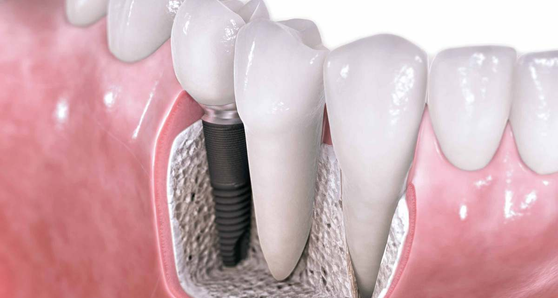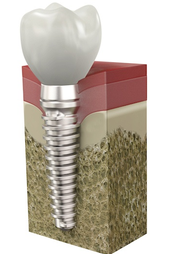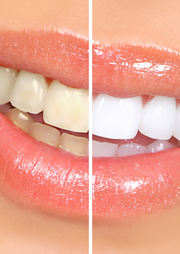Dental plaque is a biofilm formed by food residue and bacteria, which starts building up on the teeth within a few hours and is white-yellowish in colour. The gum directly in contact with it becomes inflamed: it looks redder and bleeds when it is brushed.
If plaque is not removed by brushing the teeth, after 24 hours it turns into tartar.
Tartar, or dental calculus, is hardened dental plaque, it has a rough surface and is difficult to remove. It may form above the gum as well as below it, thus creating gingival pockets.
Gengivitis is an inflammation of the gum tissue. The gums are red, swollen, and can easily bleed. This situation can be reversed by undergoing a professional hygiene session (debridement) and by maintaining correct oral care at home to allow the gums to heal.
If the progression of gingivitis is not interrupted, it may turn into periodontitis.
This is a disease of the tissues that support the teeth, which include the gums, the periodontal ligaments, and the bone. Periodontitis can be ascribed to several factors:
plaque and tartar
smoking
diabetes and other conditions
genetic predisposition
stress.
If untreated, the infection spreads deeply and the gum tissues become separated from the teeth, creating pockets in which bacteria accumulate. The bone tissues are destroyed and the teeth lose support and become mobile, eventually leading to tooth loss.
Gingival recession is the recession of the gums from their normal position towards the roots of the teeth, so that the teeth become exposed and appear longer than normal. It is caused by periodontal disease and/or incorrect and overaggressive brushing. Gingival recession may result in serious aesthetic problems (especially in relation to the front teeth) and cause dental hypersensitivity.
In the past, individual affected by periodontal disease (which used to be called "pyorrhea") could do nothing except wait for their teeth to fall out. Fortunately, the situation is now very different, since scientific research has shown that periodontitis can be treated and tooth loss can be stopped.
Your collaboration is crucial for successful treatment. Without correct oral hygiene, even the best treatment performed by the best specialist is destined to fail!
The first steps in the treatment of periodontal disease are:
- Information and motivation about correct oral hygiene, using a manual or electric brush, interdental brushes or floss, and mouthwash;
-
Checking for factors that influence the progression of the disease, such as smoking and diabetes;
-
Removing dental plaque and tartar above the gumline through debridement and below the gumline through root planing. Tartar can be removed using manual or ultrasonic instruments.
If your collaboration has been constant, at this point of the treatment the amount of plaque and tartar as well as gum inflammation and bleeding should be considerably and permanently reduced.
The next step consists in evaluating possible surgical treatments, which may consist in:
-
REGENERATIVE SURGICAL THERAPY: its purpose is to increase the amount of bone around the teeth that have been compromised by periodontal disease. It is possible to use synthetic bone grafts or your own bone taken from other parts of the mouth.
-
MUCOGINGIVAL SURGERY: it corrects defects related to the shape, position, and amount of gum in the mouth. It focuses mainly on correcting recession for aesthetic reasons, prosthetic reasons and in case of tooth hypersensitivity.
If untreated, periodontal disease may cause damage to other organs in the body, including the heart and lungs.
Clinical trial data have shown that periodontitis can increase the systemic inflammatory load, thus contributing to the onset of chronic inflammatory diseases. The bacteria found in our mouth can penetrate the gum tissue and from there move into the bloodstream, causing problems of varying degrees of severity in organs which may be very distant from the mouth.
I have heart problems, am I “at risk”?
Patients affected by heart problems certainly require thorough medical assessment, but they should personally take extremely good care of their gums, since clinical studies indicate a higher rate of cardiac and vascular diseases in patients affected by periodontitis.
I have diabetes, am I “at risk"?
Especially if not kept under control, diabetes represents a risk factor for the onset and development of periodontal disease. Moreover, it has been shown that patients affected by periodontitis find it more difficult to control their glycaemia.
Periodontal disease may also trigger the onset of respiratory infections and, in pregnant women, it can lead to premature delivery, while the newborn may be underweight. Hence, preventing periodontitis not only contributes to keeping your mouth healthy but it also helps prevent much more serious systemic diseases.
A periodontal check-up is advisable in case of family members having suffered or suffering from periodontitis.
Keeping their teeth and periodontal areas healthy is crucial for women who want to become pregnant. Research shows that pregnancy causes greater exposure to dental plaque and the presence of periodontal disease can lead to premature delivery, while the newborn may also be underweight.









